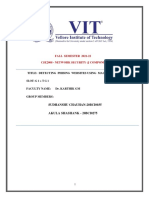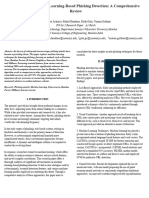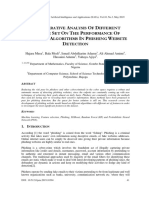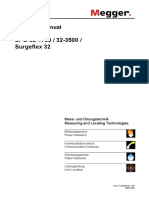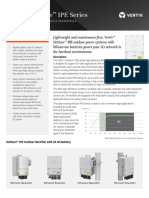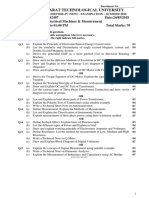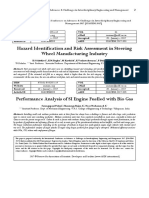Phishing Website Detection Using Machine Learning Algorithms A Data Driven Approach To Cybersecurity
Uploaded by
Editor IJTSRDPhishing Website Detection Using Machine Learning Algorithms A Data Driven Approach To Cybersecurity
Uploaded by
Editor IJTSRDInternational Journal of Trend in Scientific Research and Development (IJTSRD)
Volume 9 Issue 3, May-Jun 2025 Available Online: www.ijtsrd.com e-ISSN: 2456 – 6470
Phishing Website Detection using Machine Learning Algorithms:
A Data-Driven Approach to Cybersecurity
Mariya Zareen
Assistant Professor, Department of CSE, Lords Institute of Engineering and Technology, Hyderabad, Telangana, India
ABSTRACT How to cite this paper: Mariya Zareen
A piezoelectric shoe is a type of footwear that integrates piezoelectric "Phishing Website Detection using
materials within its sole and heel to generate electricity from Machine Learning Algorithms: A Data-
mechanical pressure. These materials produce electrical energy when Driven Approach to Cybersecurity"
Published in
compressed by the wearer's movement, converting kinetic energy
International Journal
into usable electrical power. This energy can then be harnessed to of Trend in
power electronic devices or charge batteries, offering a sustainable Scientific Research
energy solution. The technology holds significant potential for and Development
applications in various fields, including sports and fitness tracking, (ijtsrd), ISSN: 2456-
military operations, and emergency response systems. As wearable 6470, Volume-9 | IJTSRD79945
technology continues to evolve, the piezoelectric shoe stands out as Issue-3, June 2025,
an innovative way to tap into the body's natural energy. By pp.308-309, URL:
transforming the mechanical energy produced from walking or www.ijtsrd.com/papers/ijtsrd79945.pdf
running into electricity, it provides an efficient means of energy
Copyright © 2025 by author (s) and
harvesting. This abstract highlights the core functionality, potential
International Journal of Trend in
benefits, and future applications of piezoelectric shoes, demonstrating Scientific Research and Development
how they could revolutionize energy harvesting in wearable devices. Journal. This is an
KEYWORDS: Phishing Detection, Machine Learning, Random Open Access article
distributed under the
Forest, Cybersecurity, Website Classification
terms of the Creative Commons
Attribution License (CC BY 4.0)
(http://creativecommons.org/licenses/by/4.0)
1. INTRODUCTION
Cybersecurity threats have advanced significantly, Nonetheless, issues such as elevated false positive
with phishing becoming one of the most misleading rates and imbalances in datasets continue to pose
and harmful methods of attack. Phishing sites challenges.
replicate authentic websites to entice users into
3. PROPOSED METHODOLOGY
revealing sensitive information, including login
This research utilizes the Phishing Websites dataset
details, financial data, and social security numbers.
sourced from UCI, comprising 11,055 entries and 30
Given the ever-changing landscape of phishing
attributes. These attributes encompass URL
attacks, traditional rule-based detection methods characteristics, SSL certificate status, domain age,
frequently fall short. This highlights the need for
and analysis of HTML content. Three machine
adaptive and intelligent solutions, such as machine
learning models were employed: • Random Forest:
learning (ML) models, to ensure prompt and precise An ensemble technique that constructs several
detection. key concepts: piezoelectricity and
decision trees. • SVM: Well-suited for high-
2. LITERATURE REVIEW dimensional feature spaces. • Decision Tree: A
The literature review indicates that recent research straightforward and interpretable model. The dataset
has revealed the effectiveness of machine learning underwent preprocessing, which included addressing
techniques in identifying phishing attempts through missing values, encoding categorical variables, and
the analysis of URL structures, domain information, dividing the data into 70% for training and 30% for
and website metadata. Abdelhamid et al. (2014) testing.
showcased a high level of accuracy with a hybrid
Theoretical analysis suggests that when
approach utilizing various classification models.
electromagnetic waves are directed through a highly
Additionally, Sahingoz et al. (2019) investigated the
angular waveguide, evanescent waves are produced,
use of natural language processing for extracting
which carry no energy. When a properly resonant
URL features to enhance phishing detection.
@ IJTSRD | Unique Paper ID – IJTSRD79945 | Volume – 9 | Issue – 3 | May-Jun 2025 Page 308
International Journal of Trend in Scientific Research and Development @ www.ijtsrd.com eISSN: 2456-6470
waveguide is placed near the transmitter, these learning techniques, with Random Forest emerging as
evanescent waves can tunnel the energy to the the most effective model. Future investigations could
receiver coil, where it can be rectified into DC power. explore deep learning methodologies and the
Since the waves "tunnel" rather than propagate implementation of real-time detection systems via
through the air, they avoid energy loss, interference browser extensions or network-level assessments.
with other devices, or potential harm to humans.
REFERENCES:
4. EXPERIMENTAL SETUP [1] Abdelhamid, N., Ayesh, A., & Thabtah, F.
Experiments were carried out utilizing the scikit-learn (2014). Phishing detection based on hybrid
library in Python. The evaluation metrics included: intelligent model. Expert Systems with
• Accuracy • Precision • Recall • F1-Score 5. Results Applications, 41(13), 5948-5959.
and Discussion The Random Forest model
[2] Sahingoz, O. K., Buber, E., Demir, O., & Diri,
demonstrated the best performance: Model Accuracy B. (2019). Machine learning based phishing
Precision Recall F1-Score Random Forest 96.2% detection from URLs. Expert Systems with
95.8% 96.5% 96.1% SVM 93.4% 92.1% 94.0% Applications, 117, 345–357.
93.0% Decision Tree 91.7% 90.2% 91.5% 90.8%
These findings indicate that ensemble methods [3] UCI Machine Learning Repository. (2020).
exhibit greater robustness and superior generalization Phishing Websites Dataset. [Online] Available
in detecting phishing attempts. at:
https://archive.ics.uci.edu/ml/datasets/Phishing
5. CONCLUSION
+Websites
In conclusion, this research highlights the substantial
enhancement of phishing detection through machine
@ IJTSRD | Unique Paper ID – IJTSRD79945 | Volume – 9 | Issue – 3 | May-Jun 2025 Page 309






















